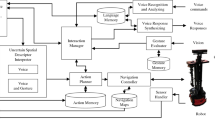Abstract
In this paper we motivate the use of qualitative spatial actions as the fundamental unit in processing user route instructions. The spatial action model has been motivated by an analysis of empirical studies in human-robot interaction on the navigation task, and can be interpreted as a conceptual representation of the spatial action to be performed by the agent in their navigation space. Furthermore, we sketch out two distinct models of interpretation for these actions in cognitive robotics. In the first, the actions are related to a formalized conceptual user modeling of navigation space, while in the second the actions are interpreted as fuzzy operations on a voronoi graph. Moreover, we show how this action model allows us to better capture the points at which user route instructions become out of alignment with a robot’s knowledge of the environment through a number of examples.
Access this chapter
Tax calculation will be finalised at checkout
Purchases are for personal use only
Preview
Unable to display preview. Download preview PDF.
Similar content being viewed by others
References
Allen, J.F.: Maintaining knowledge about temporal intervals. CACM 26(11), 832–843 (1983)
Bugmann, G., Klein, E., Lauria, S., Kyriacou, T.: Corpus-Based Robotics: A Route Instruction Example. In: Proceedings of IAS-8 (2004)
Chronis, G., Skubic, M.: Robot navigation using qualitative landmark states from sketched route maps. In: Proceeding of the IEEE 2004 International Conference on Robotics and Automation, pp. 1530–1535. IEEE Computer Society Press, Los Alamitos (2004)
Cohn, A.G., Bennett, B., Gooday, J., Gotts, N.M.: Qualitative spatial representation and reasoning with the region connection calculus. Ceoinformatics 1, 1–44 (1997)
Denis, M.: The description of routes: A cognitive approach to the production of spatial discourse. Cahiers de Psychologie Cognitive 16, 409–458 (1997)
Fischer, K.: What Computer Talk Is and Is not: Human-Computer Conversation as Intercultural Communication. Computational Linguistics 17 (2006)
Freksa, C.: Qualitative spatial reasoning. In: Mark, D.M., Frank, A.U. (eds.) Cognitive and Linguistic Aspects of Geographic Space, Kluwer Academic Publishers, Dordrecht (1991)
Freksa, C.: Using orientation information for qualitative spatial reasoning. In: Frank, A.U., Formentini, U., Campari, I. (eds.) Theories and Methods of Spatio-Temporal Reasoning in Geographic Space. LNCS, vol. 639, pp. 162–178. Springer, Heidelberg (1992)
Krieg-Brückner, B., Frese, U., Lüttich, K., Mandel, C., Mossakowski, T., Ross, R.J.: Specification of route graphs via an ontology. In: Freksa, C., Knauff, M., Krieg-Brückner, B., Nebel, B., Barkowsky, T. (eds.) Spatial Cognition IV. LNCS (LNAI), vol. 3343, pp. 989–995. Springer, Heidelberg (2005)
Krieg-Brückner, B., Shi, H.: Orientation calculi and route graphs: Towards semantic representations for route descriptions. In: Raubal, M., Miller, H.J., Frank, A.U., Goodchild, M.F. (eds.) GIScience 2006. LNCS, vol. 4197, Springer, Heidelberg (2006)
Kuipers, B.: The spatial semantic hierarchy. Artificial Intelligence 119, 191–233 (2000)
Lauria, S., Bugmann, G., Kyriacou, T.: Training personal robots using natural language instruction. IEEE Intelligent Systems 16(3), 38–45 (2001)
Lauria, S., Kyriacou, T., Bugmann, G., Bos, J., Klein, E.: Converting natural language route instructions into robot executable procedures. In: Proceedings of the 2002 IEEE International Workshop on Human and Robot Interactive Communication, pp. 223–228. IEEE Computer Society Press, Los Alamitos (2002)
MacMahon, M.: A framework for unterstanding verbal route instructions. In: Proceedings of AAAI Fall Symposium on the Intersection of Cognitive Science and Robotics: From Interfaces to Intelligence (2004)
Nijenhuis, A., Wilf, H.: Combinatorial Algorithms. Academic Press, London (1978)
Reason, J.: Human Error. Cambridge University Press, Cambridge (1990)
Renz, J., Mitra, D.: Qualitative direction calculi with arbitrary granularity. In: Zhang, C., W. Guesgen, H., Yeap, W.-K. (eds.) PRICAI 2004. LNCS (LNAI), vol. 3157, pp. 65–74. Springer, Heidelberg (2004)
Shi, H., Tenbrink, T.: Telling rolland where to go: Hri dialogues on route navigation. In: WoSLaD Workshop on Spatial Language and Dialogue (October 23-25, 2005)
Skubic, M., Matasakis, P., Forrester, B., Chronis, G.: Extracting navigation states from a hand-drawn map. In: Proceeding of the IEEE 2001 International Conference on Robotics and Automation, IEEE Computer Society Press, Los Alamitos (2001)
Talmy, L.: How language structures space. In: Pick, H.L., Acredolo, L.P. (eds.) Spatial Orientation: Theory, Research and Application (1983)
Tenbrink, T.: Identifying objects in english and german: Empirical investigations of spatial contrastive reference. In: WoSLaD Workshop on Spatial Language and Dialogue (October 23-25, 2005)
Tenbrink, T.: Identifying objects on the basis of spatial contrast: an empirical study. In: Freksa, C., Knauff, M., Krieg-Brückner, B., Nebel, B., Barkowsky, T. (eds.) Spatial Cognition IV: Reasoning, Action, Interaction. International Conference Spatial Cognition 2004, Frauenchiemsee, Germany, October 2004, pp. 124–146. Springer, Heidelberg (2005)
Theobalt, C., Bos, J., Chapman, T., Espinosa-Romero, A.: Talking to godot: Dialogue with a mobile robot. In: Proceedings of the 2002 IEEE International Conference on Intelligent Robots & Systems, pp. 1338–1343. IEEE Computer Society Press, Los Alamitos (2002)
Thrun, S.: Robotics mapping a survey. In: Lakemeyer, G., Nebel, B. (eds.) Exploring Artificial Intelligence in the New Millenium, Morgan Kaufmann, San Francisco (2002)
Tversky, B.: Structures of mental spaces – how people think about space. Environment and Behavior 35(1), 66–80 (2003)
Tversky, B., Lee, P.: How space structures language. In: Freksa, C., Habel, C., Wender, K.F. (eds.) Spatial Cognition. LNCS (LNAI), vol. 1404, pp. 157–175. Springer, Heidelberg (1998)
Werner, S., Krieg-Brückner, B., Hermann, T.: Modelling navigational knowledge by route graphs. In: Habel, C., Brauer, W., Freksa, C., Wender, K.F. (eds.) Spatial Cognition II. LNCS (LNAI), vol. 1849, pp. 259–316. Springer, Heidelberg (2000)
Zimmermann, K., Freksa, C.: Qualitative spatial reasoning using orientation, distance, and path knowledge. Applied Intelligence 6, 49–58 (1996)
Author information
Authors and Affiliations
Editor information
Editors and Affiliations
Rights and permissions
Copyright information
© 2007 Springer-Verlag Berlin Heidelberg
About this paper
Cite this paper
Shi, H., Mandel, C., Ross, R.J. (2007). Interpreting Route Instructions as Qualitative Spatial Actions. In: Barkowsky, T., Knauff, M., Ligozat, G., Montello, D.R. (eds) Spatial Cognition V Reasoning, Action, Interaction. Spatial Cognition 2006. Lecture Notes in Computer Science(), vol 4387. Springer, Berlin, Heidelberg. https://doi.org/10.1007/978-3-540-75666-8_19
Download citation
DOI: https://doi.org/10.1007/978-3-540-75666-8_19
Publisher Name: Springer, Berlin, Heidelberg
Print ISBN: 978-3-540-75665-1
Online ISBN: 978-3-540-75666-8
eBook Packages: Computer ScienceComputer Science (R0)




